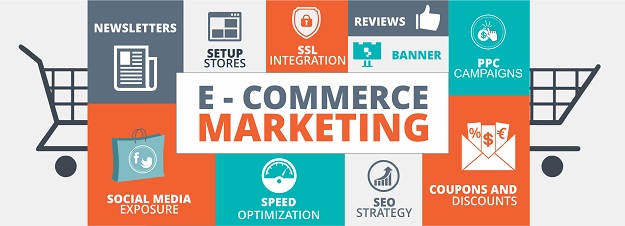Marketing a startup e-commerce brand online is a complex task involving a number of different marketing tools such as SEO, content marketing, onsite optimization, guest posting, social media, email marketing, and so forth. Few entrepreneurs are well-versed in these diverse aspects of digital marketing, which is why you’ll find the following tips helpful to gain a better understanding of how e-commerce marketing works.
1. Plan a detailed digital marketing campaign
Planning is the first crucial step in devising a successful online marketing strategy. Use the help of a digital marketing expert to determine your focus areas in the initial stages and to devise a robust campaign that will deliver.
2. Create interesting content
The content that you create to establish your brand’s online presence should be original, interesting and relevant to your target audience. Maintain a level of quality and avoid plagiarizing no matter what.
3. Use email marketing, but don’t overdo it
Email marketing continues to be a favorite with digital marketers because of its wide, unobtrusive reach. More people click on emails than on banner advertisements, and that is why email marketing is preferred as a mode of reaching a large audience of prospective customers. Remember not to inundate your audience with too many or poorly crafted emails.
4. Use long-form content
Long articles and blog posts have been known to capture the attention of discerning readers who prefer high-quality informative content to memes and unimaginative articles. Use long-form content to share your expertise, brand story, processes and accomplishments with your audience.
5. Use the power of videos and live-streaming
Based on the product or service you offer, videos and/or live streaming is a great way to capture people’s attention. For instance, if you’re a real estate company, create virtual tours of your listings. If you’re a local catering startup, give your audience a tour of your workshop or record/live-stream an event where you’ve catered. Create videos that your customers will find helpful, informative and engaging.
6. Make an FAQ page
Local businesses often underestimate the value of an FAQ page on their website, which is why not all ecommerce stores offer FAQs. Irrespective of the product or service you offer or the type of clients you service (B2B or individual), add an FAQ page to your website and try to answer all potential questions your customers may have.
7. Invest in a well-designed SEO strategy
Do it in-house if you have an SEO expert in your team or outsource to an experienced SEO agency—but don’t underestimate the power of a good SEO strategy in driving your business forward. Use the right keywords, optimize your onsite and offsite content, and make sure the quality of content is in line with your brand image.
8. Use photos to improve user involvement
Use professionally done photos on your website, in blog posts and in content created for guest posts on other websites. Stunning photos are a great way to a capture visitors’ attention.
9. Get positive reviews
Reach out to your happy customers and request them to leave reviews on your website or via email. Another way to gain authentic, unbiased reviews is by sending free samples of your products to influential bloggers in your niche.
10. Share your expertise and knowledge on LinkedIn
Publish useful content on LinkedIn and social media, talk about industry news and updates, share your thoughts on the latest innovation—present your ideas and expertise to your current and future customers to gain trust and credibility.
11. Try PPC (pay-per-click) adverts
Create a good PPC campaign through Google AdWords to reach your target demographic through Google ads. PPC advertising instantly brings your ecommerce website on top without any SEO. It is an effective marketing tool to boost traffic to your e-store particularly when you’re starting out.
12. Redo your ecommerce store
Your ecommerce store should load fast on all devices and it should be innovative, responsive, well-designed and user-friendly. Mark Friedman, founder of Goshly.com, recommends that because trends change online so quickly, you should update your website design every couple of years.
Take a good look at your ecommerce store and don’t hesitate to give it an overhaul for enhanced user experience.
13. Develop a mobile app
More and more online shoppers are using mobiles and tablets to buy products and services. Invest in a well-designed mobile app to reach the large pool of mobile shoppers.
14. Test the check-out process
This is particularly important if your cart abandon rate is too high. Test the check-out process to understand why customers are leaving your store without buying. Your check-out process should be short and simple. Fix the pain points for a seamless and hassle-free user experience.
15. Offer free shipping and express delivery
Customers love free shipping and most will quickly shift loyalties to an e-store that offers the same or similar products at zero or less shipping charges. Fast delivery is another winner with ecommerce customers who want or need express delivery. Integrate these two features into your shipping process as soon as possible.
16. Keep track of numbers
Whether it’s your website traffic, PPC ad clicks, video views, social media engagement, completed purchases, abandoned carts or any other data that affects your online sales, tracking numbers should be an integral part of your ecommerce marketing strategy.
If you don’t have the expertise or know-how to analyze digital marketing data, hire a professional digital expert to know what you’re doing right and where you need fresh thinking.
17. Use social media wisely
Social media is a wonderful marketing platform; however, your social media campaign should be focused on a couple of platforms initially. Another important factor is consistency of posting updates on social media—with so much information vying for your audience’s attention, out of sight quickly becomes out of mind.
Use a social media automation tool to automate updates if you don’t have the time to post regularly, but ensure that the content is original and interesting.

